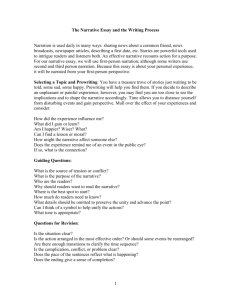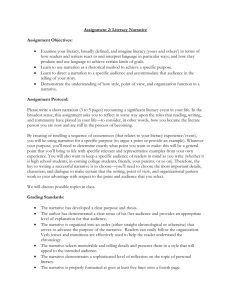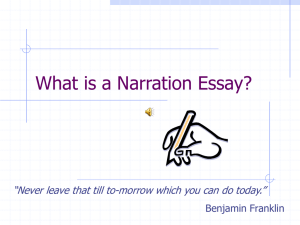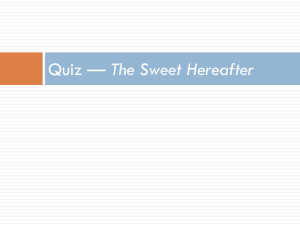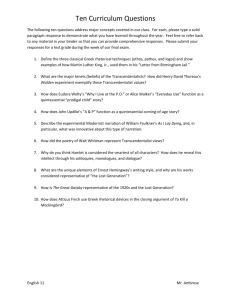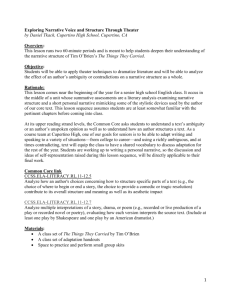Narration & Description - Wiki-cik
advertisement
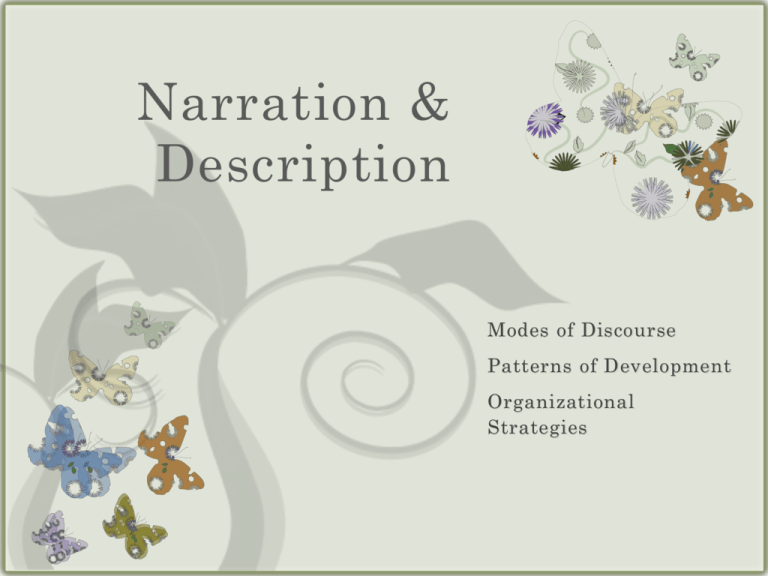
Narration & Description Modes of Discourse Patterns of Development Organizational Strategies Narration & Description Background Narration – telling a story to make a point Description – evoking the senses to create a picture BEST when used together for writing a detailed account of some memorable experience First trip alone Last-minute political victory Picnic in some special place Narration & Description Purpose Introduce or illustrate a complicated subject Analyze an issue or theme Often used to support some other strategy such as causal analysis or argument Example: new awareness of patriotism because of travel in a foreign country Narrative purpose (what happened) and descriptive purpose (what it felt like) linked to other purposes Could explain what caused new awareness (why it happened) or to argue that everyone needs such awareness (why everyone should reach the same conclusions) Report actions and describe feelings Autobiography, history, fiction (most common) Narration & Description Audience Consider How much do I tell my audience? (narration) Personal experience – few people will know it before you tell it Add or delete material to fit occasion How much do I show my audience? (description) Unusual subject – include a lot of info, especially if it’s technical New images & insights that create a fresh vision of the subject Narration & Description Strategies Beginning Experiences and an essay about the experience are NOT the same Memory will be disorganized and poorly defined Experience to essay Locate the central conflict Between writer & himself Between writer & others Between writer & environment Narration & Description Strategies (cont’d) After identifying the conflict Arrange action so readers know How conflict started How it developed, and How it was resolved. Types of arrangement (choose pattern according to purpose) Simple chronological order (1, 2, 3, 4, …) Angelou’s “My Name is Margaret” – describes an evolution of events leading up to the broken china Start in the middle or near the end (4, … 1, 2, 3) Williams’ “The Village Watchman” – describes impact of social stigma Narration & Description Strategies (cont’d) After identifying the conflict & deciding the plot sequence Establish pace – the speed at which the writer recounts events Quick – omit details, compress time, summarize experience Slow & careful – include every detail, expand on time, present the situation as a fully realized scene Select details – make scenes and summaries effective Special details that satisfy the needs of readers and further your purpose Objective or technical to help reader understand Subjective or impressionistic to appeal to readers’ senses Figurative image or create dominant impression Narration & Description Strategies (cont’d) In order to identify the conflict, decide the plot sequence, vary the pace, and select details Determine point of view “I” OR “he” or “she” Choose position – how close do you want to be to the action in time and space Involved in action View it as an observer Tell as events are happening or many years after they’ve taken place Narration & Description Points to Remember 1. Focus your narrative on the “story” in your story – that is, focus on the conflict that defines the plot. 2. Vary the pace of your narrative so that you can summarize some events quickly and render others as fully realized scenes. 3. Supply evocative details to help your readers experience the dramatic development of your narrative. 4. Establish a consistent point of view so that your readers know how you have positioned yourself in your story. 5. Represent the events in your narrative so that your story makes its point. In this excerpt from her graphic novel Persepolis: The Story of a childhood (2003), Marjane Satrapi recounts the reaction of young schoolgirls to the law requiring them to wear “the veil.” Some argue that the veil debases and even erases female identity. Others argue that it provides women with safety and secret power. How do the characters in Satrapi’s narrative feel about this regulation? Read Judith Ortiz Cofer ’s “The Myth of the Latin Woman: I Just Met a Girl Named Maria” Purpose Why does Cofer introduce the conflict between custom and chromosomes ? How does this conflict help explain the concept of stereotype ? How does this narrative help accomplish Cofer ’s “personal goal in her public life?” Audience In what ways does Cofere use the references to Maria and Evita to identify her audience? How does she use the example of the piropos to educate her audience? Strategies How does Cofere use the details of Career Day to explain how a cultural stereotype is perpetuated? How does she manipulate point of view at her “first public poetry reading” to illustrate how she intends to change that stereotype?
